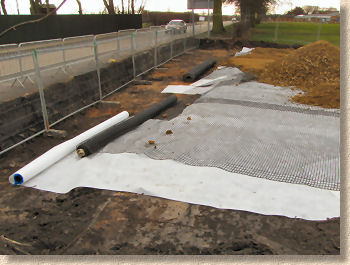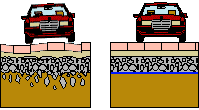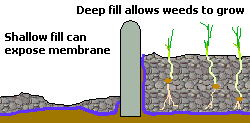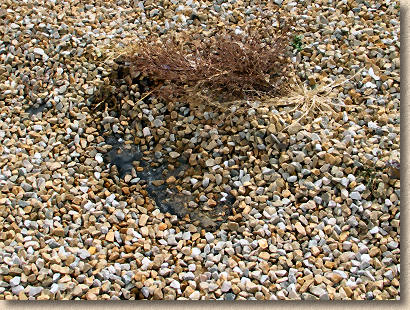The use of landscape fabrics
Due to the prevalence of TV gardeners and DIY makeover programmes, the use of a landscape fabric, ie a rot-proof, permeable, woven or non-woven membrane, between the surface dressing (bark or gravel) and the sub-grade , has apparently become mandatory. However, they are not quite the marvellous boons these people would have us believe, and on small projects they can be more of a handicap.
The basic premise that landscape fabrics work upon, namely that they prevent the surface dressing disappearing into the sub-grade and suppress weed growth, is fine, but doesn't give the full picture. They were originally developed as weed-control fabrics for commercial planting schemes, the often scruffy assemblage of shrubs, perennials and chip wrappers we see everyday at retail parks and leisure centres. By planting the greenery through holes or slits in the fabric and then covering with a generous mulch of bark, gravel or other surface dressing, the idea was to reduce the amount of maintenance required to keep the planters looking neat, tidy and free of weeds. This principle was soon adopted in the construction of childrens' playgrounds, where a landscape fabric at the base of a bark covered play area prevents the sub-grade mixing with the bark, which could soil childrens' clothes or render the area 'unplayable', and makes replacement of the bark or other safety dressing on a regular basis a good bit easier.
They are part of a range of products known generically as geo-synthetics that are widely used in earthworks projects for ground stabilisation and erosion control, in ground-water drainage schemes as particulate filters or as fin drains , and as root barriers protecting foundations, utilities etc. It is their ability to allow water to pass through freely whilst presenting an impenetrable obstruction to roots and shoots that leads to their popularity as landscape fabrics.


It should be noted that the landscape fabrics available from garden centres and the like, such as 'Mypex ®', are generally not suitable for ground reinforcement. If you need to stabilise an earth bank or strengthen a poor sub-grade, you will need a specific geo-synthetic as recommended by a civil engineer following a thorough site investigation.
As stated above, the landscape fabrics can be of great benefit to commercial planting schemes and they can be beneficial in reducing weed invasion of bark or gravel areas around the home, but they have limited use beneath paths, drives and other areas that are regularly trafficked by people or vehicles.

The relatively thin surface dressing is very easily scuffed off by wheels, kids, and pets, or even blown away, exposing the unsightly membrane. If buried to a reasonable depth, say 100mm, to prevent this exposure, they lose what are seen as their benefits, as that depth of gravel or bark is sufficient to allow weeds to germinates and thrive above the membrane. Further, it's damned hard work walking across 100mm depth of gravel, and so, what was intended to be a problem-solver has actually turned into a problem in its own right.
So, to summarise, landscape fabrics can be very useful for decorative gravel or bark areas , such as scree/alpine beds or planter areas, are a boon to deep-filled play areas, but can cause more problems than they solve beneath paths and driveways if not well-buried.
The main pros and cons are....
- Reduce (but not completely eliminate) the growth of weeds
- Prevent mixing of surface dressing with sub-grade
- Surface dressing is quickly scuffed off trafficked areas
- No evidence that these fabrics extend the usable life of a bark as a path dressing
- Relatively expensive, possibly more per m² than the surface dressing

Links:
Terram Direct - online ordering for landscape and patio fabrics
Hy-tex - Textiles for Civil Engineering, Construction, Landscaping, Horticulture and Agriculture
Peter Scott Tree Care - Root barriers
TDP Ltd - UK Distributor of Plantex

